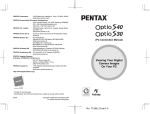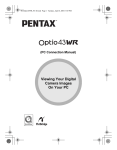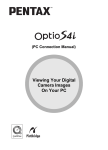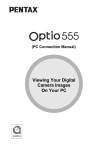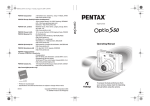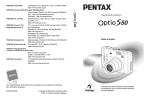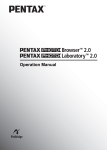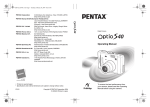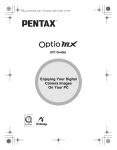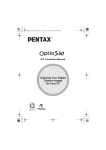Download Asahi Pentax DigiBino DB100 Operating Manual
Transcript
BINOCULARS WITH A BUILT-IN DIGITAL CAMERA Operating Manual To ensure the best performance from your DIGIBINO, please read this Operating Manual before using the DIGIBINO. Thank you for buying the Pentax DIGIBINO DB100. Please read this manual before using this product in order to get the most out of all the features and functions. Keep this manual safe, as it can be a valuable tool in helping you to understand this product’s capabilities. Regarding copyrights Images taken using the DIGIBINO that are for anything other than personal enjoyment cannot be used without permission according to the rights as specified in the Copyright Act. Please take care, as there are even cases where limitations are placed on taking pictures even for personal enjoyment during demonstrations, industrial enterprise or as items for display. Images taken with the purpose of obtaining copyrights also cannot be used outside the scope of use of the copyright as laid out in the Copyright Act, and care should be taken here also. To users of the DIGIBINO • There is a possibility that recorded data may be erased or that DIGIBINO may not function correctly when used in surroundings such as installations generating strong electromagnetic radiation or magnetic fields. • The liquid crystal panel used in the LCD display is manufactured using extremely high precision technology. Although the level of functioning pixels is 99.99% or better, you should be aware that 0.01% or fewer of the pixels may not illuminate or may illuminate when they should not. However, this has no effect on the recorded image. Regarding trademarks • PENTAX, DIGIBINO are trademarks of Asahi Optical Co., Ltd. • All other brands or product names are trademarks or registered trademarks of their respective companies. The illustrations and the display screen of the LCD monitor in this manual may be different from the actual product. FOR SAFE USE OF YOUR DIGIBINO Sufficient attention has been paid to the safety of this product but please pay particular attention to the warnings indicated by the following symbols during use. These symbols indicate that improper handling poses a high risk of causing death or serious injury. These symbols indicate that improper handling poses a risk of causing injury or damage to the product or property. WARNING NEVER look at the sun using the DIGIBINO. • NEVER look at the sun using the DIGIBINO. Serious damage to the retina, or total loss of eyesight may occur. • Do not leave the DIGIBINO in direct sunlight. Sun rays passing through this product will be intensified, and should they focus on flammable materials, fire may occur. • Do not attempt to take the DIGIBINO apart or remodel the DIGIBINO, as there is a danger of receiving an electric shock. • If the inside of the DIGIBINO should become exposed as a result of, for example, this product being dropped, please do not under any circumstances touch such exposed portions, as there is a danger of receiving an electric shock. 1 • Wrapping the strap of this product around your neck is also dangerous. Please take care that small children do not hang the strap around their necks. • If the batteries fluid come in contact with your eyes, do not rub them. Flush your eyes with clean water and get medical attention immediately. • If the batteries fluid come in contact with skin or clothes, wash affected areas thoroughly with water. • Defective batteries could possibly become flammable. Do not attempt to touch the product if this occurs. • Carefully remove the batteries if they explode or start smoking. Take care not to get burned if the batteries are hot. • Some portions of the DIGIBINO heat up during use, so please take care, as there is a risk of low temperature burns if such portions are held for long periods of time. • Do not use the DIGIBINO while walking as depth perception and peripheral vision are dramatically altered. • Caution should be taken when adjusting the DIGIBINO barrels to avoid fingers being pinched. • Using the DIGIBINO for an extended period of time may cause inflammation where the eyepieces and strap come in contact with skin. • Do not swing the DIGIBINO by the neck strap. 2 Care to be Taken During Handling • Do not direct the DIGIBINO to the sun with the lens barrier open. It may damage the image pickup device. • When the DIGIBINO has not been used for a long time, confirm that it is still working properly, particularly prior to taking important pictures. Pentax is not responsible for consequential damages (costs incurred as a result of taking pictures, loss of benefits that were to be obtained through taking pictures) arising from failure of this product. • Do not apply excessive force when adjusting the central focusing wheel, diopter adjusting ring, or eyepiece width. • Ensure that this product is not subjected to substantial vibrations, shocks or pressure. Place this product on a cushion for protection when this product is subjected to the vibrations of a motorbike, car, or ship, etc. • Do not use the DIGIBINO where it may come in contact with rain, water or any other liquid, because this product is not weather, water, or liquid resistant. • The temperature range in which this product can be used is 0°C to 40°C (32°F to 104°F). • Places of high temperature and humidity should be avoided. Particular care should be taken regarding vehicles, which can become very hot inside. • The liquid crystal display will become black at temperatures of approximately 60°C (140°F) but will return to normal when normal temperatures are returned to. • The response speed of the liquid crystal display becomes slow at low temperatures. This is due to the properties of the liquid crystal and is not a fault. • If the DIGIBINO is subjected to rapid temperature changes, condensation may form on the inside and outside of this product. Therefore put the DIGIBINO in a bag or plastic bag, and take this product out when the difference in temperature has subsided. • Avoid contact with garbage, dirt, sand, dust, water, toxic gases, salt, etc. as this may cause damage to the DIGIBINO. If rain or drops of water get onto the DIGIBINO, please wipe dry. 3 • Do not clean this product with organic solvents such as thinner or alcohol benzene. • Storing the camera where pesticides and chemicals are handled should be avoided. Remove from case and store in a well-ventilated place to prevent the DIGIBINO from becoming moldy during storage. • Periodic checks are recommended every 1 to 2 years in order to maintain high-performance. Handling Batteries • Use two size AA alkaline batteries, two size AA nickel hydride (NiMH) batteries, or one CR-V3 lithium battery pack. • The number of digital photos you can take may be reduced depending on the shooting conditions, environment, and batteries. • Manganese batteries cannot be used. Manganese batteries are short in service life and in addition heat generation may damage the DIGIBINO. • Use the batteries correctly. Incorrect use may cause leakage, heat generation, and damage. When replacing a battery, place it correctly while noting the directions of the + and - markings. • Generally, battery performance is temporarily deteriorated as temperature decreases. When the DIGIBINO is used in a cold environment, keep this product warm by holding it in some protection against cold or inside the clothes. Battery performance once deteriorated due to low temperature will be recovered when the batteries are returned to room temperature. • The cathode or anode of a battery stained with sweat or oil may cause poor contact. Wipe it well with dry cloth before use. • It is recommended to carry spare batteries when you go out for a long-term journey. Especially in foreign countries, compatible batteries may be unavailable depending on the region. 4 Contents FOR SAFE USE OF YOUR DIGIBINO ······················································································ 1 Care to be Taken During Handling ···························································································· 3 Contents ···································································································································· 5 Contents of the Operating Manual ···························································································· 7 Names of Parts ·························································································································· 8 Checking the Contents of the Package ··················································································· 10 Getting Started .......................................................................................................................... 11 Attaching the Strap ·················································································································· Adjusting the Eyepiece Width ·································································································· Adjusting the Diopter Control ·································································································· Using the DIGIBINO as Binoculars ·················································································· Installing Batteries ··················································································································· Setting the Date/Time ·············································································································· 11 11 13 14 15 18 Quick Start ................................................................................................................................. 20 Taking Pictures ························································································································ Taking Pictures Using the LCD Monitor ··········································································· Playing Back Pictures ·············································································································· Playing Back a Single Image ··························································································· Playing Back the Last Image Taken (One-touch View) ···················································· 20 21 22 22 23 Modes and Menus ..................................................................................................................... 24 Changing the Mode ················································································································· Using the Menus ······················································································································ How to Use the Menus ···································································································· Menu List ························································································································· 24 25 25 27 Taking Pictures .......................................................................................................................... 29 Displaying Shooting Information ······························································································ Selecting the Image Quality (Resolution) ················································································ Changing the Size of the Subject (Digital Zoom) ···································································· Continuous Shooting ··············································································································· 29 30 31 32 5 Playback/Deleting ...................................................................................................................... 33 Displaying Image Information ·································································································· 33 Nine-image Display (Thumbnail) ····························································································· 34 Playing Back Images Continuously (Slideshow) ····································································· 36 Zoom Display (Special Zoom) ································································································· 37 Deleting Images ······················································································································· 38 Deleting the Last Image Taken (One-touch Deletion) ······················································ 38 Deleting a Single Image ·································································································· 39 Deleting All Images ·········································································································· 40 Saving Important Images from Deletion (Protect) ··································································· 42 Viewing Images on a TV ·········································································································· 43 Settings ...................................................................................................................................... 44 Initializing All Memory (Format) ······························································································· Setting the Date Style ·············································································································· Adjusting the Date/Time ·········································································································· Changing the Display Language ····························································································· Turning the Beep On/Off ·········································································································· Auto Power Off Function ·········································································································· Resuming from the Auto Power Off status ······································································ Resetting to Default Settings (Reset) ······················································································ 44 45 46 47 48 49 50 51 Viewing Images with a PC ........................................................................................................ 52 Viewing Images with Windows PC ·························································································· Installing the software (only for Windows 98SE) ····························································· Connecting the DIGIBINO and PC ·················································································· Viewing images on your PC ···························································································· Disconnecting the DIGIBINO from your PC ···································································· Viewing Images with Macintosh ······························································································ Installing the software ······································································································ Connecting the DIGIBINO and your Macintosh ······························································· Viewing images on your Macintosh ················································································· Disconnecting the DIGIBINO from your Macintosh ························································· 52 53 56 56 57 59 60 61 62 62 Appendix .................................................................................................................................... 63 Messages ································································································································ Troubleshooting ······················································································································· Main Specifications ·················································································································· WARRANTY POLICY ·············································································································· 6 63 64 66 67 Contents of the Operating Manual This Operating manual contains the following chapters. ● Getting Started This chapter explains how to use the DIGIBINO as binoculars, and what you need to do after purchasing this product before you start taking pictures. Be sure to read it and follow the instructions. ● Quick Start This chapter explains the simplest way to take pictures and play back images. Use it if you want to start taking pictures straightaway. ● Modes and Menus This chapter explains common operations such as how to change the mode, and how to use the menus. For more details, refer to the respective “Taking Pictures”, “Playback/Deleting” and “Settings” chapters. ● Taking Pictures This chapter explains the various ways of capturing images and how to set the relevant functions. ● Playback/Deleting This chapter explains how to play back images on the DIGIBINO or on a TV and how to delete images. ● Settings This chapter explains how to set the DIGIBINO’s functions. ● Viewing Images with a PC This chapter explains how to view recorded images with a PC using the software included CD-ROM. ● Appendix This tells you about the messages displayed on the LCD monitor and what to do in the event of trouble. 7 Names of Parts Objective lenses LCD monitor (when closed) Left cover Right cover USB/Video output terminal cover Battery chamber cover Slide lever Lens barrier (when open: taking images) Tripod socket Opening the LCD monitor Caution Do not apply excessive force when opening the LCD monitor. 8 LCD monitor (when opened) MENU button buttons Central focusing wheel OK button Strap lug DISPLAY button Left diopter adjusting ring Shutter release button Eyepiece lenses Right diopter adjusting ring Status lamp Strap lug 9 Checking the Contents of the Package Main Unit (DB100) Size AA alkaline batteries (2) Strap USB cable Video cable Software (CD-ROM) (K-SW1) BINOCULARS WITH A BUILT-IN DIGITAL CAMERA Operating Manual To ensure the best performance from your DIGIBINO, please read the Operating Manual before using the DIGIBINO. Soft case 10 Operating Manual (this manual) Warranty card Attaching the Strap Attach the included strap as shown in the illustrations below. ¡ ™ Getting Started 3 2 1 Caution Pentax will assume no responsibility for damage that may occur if the product is dropped due to the incorrect attachment of the strap. 11 Adjusting the Eyepiece Width The DIGIBINO eyepiece distance adjusts for optimal viewing through the eyepiece lenses. ¡ Raise the LCD monitor. Getting Started ™ Turn the central focusing wheel to slide out the eyepiece lenses. £ While looking at an object through both the right and left eyepiece lenses, slide the cover outward or inward to adjust the eyepiece separation so you can see a single image with both eyes. 12 Adjusting the Diopter Control The DIGIBINO diopter can be adjusted according to your eyesight. ¡ Direct the DIGIBINO to a light area and look Neither the object nor the indication are sharp. Indication Getting Started through the right eyepiece lens with your right eye. ™ Turn the right diopter adjusting ring until the indication appears sharp. At this stage, the object may not appear sharp. £ Next, turn the central focusing wheel until the object appears sharp with your right eye. Now, you can view both the indication and object sharply with your right eye. 13 ¢ Turn the left diopter adjusting ring until the object appears sharp with your left eye. Now, you can view the object in focus with both eyes and the indication appears sharp with your right eye. Getting Started Caution The diopter and focus must be adjusted completely to obtain properly focused images when shooting photos. Once you finish these adjustments, all you have to do thereafter is to turn the central focusing wheel to focus on desired objects. It automatically adjusts the focus of the binoculars and camera together. Using the DIGIBINO as Binoculars Once you finish eyepiece width, diopter, and focus adjustments, you can use the DIGIBINO as binoculars. No batteries are required for using the DIGIBINO as binoculars. Use the central focusing wheel to focus on objects. 14 Installing Batteries Batteries that can be used in the DIGIBINO The following batteries can be used in the DIGIBINO: Caution • Size AA manganese batteries cannot be used. • Refer to “Handling Batteries” (p. 4). Getting Started Size AA alkaline batteries (2), size AA nickel hydride (NiMH) batteries (2), CR-V3 lithium battery pack (1) ¡ Pull the battery chamber cover toward the eyepiece lens while pressing the side of the cover. 15 ™ Open the battery chamber cover. Battery takeup tape Getting Started £ Insert two size AA batteries into the battery chamber with the battery takeup tape underneath. Insert the batteries correctly with regard to polarity (+ and –) marked on the battery and battery chamber. Caution • If the batteries are placed in wrong directions, power cannot be turned on. • If a CR-V3 lithium battery pack is inserted, also make sure the polarity marks. • Be sure to place the battery takeup tape under the batteries. Otherwise, you may find it hard to remove the batteries. ¢ Close the battery chamber cover. After closing the battery chamber cover, slide it toward the objective lenses to lock it. 16 Battery Level Indicator You can check the battery level by viewing the symbol LCD monitor. : Adequate power remains. (lit green) : Battery is running low. (lit yellow) : Battery is running very low. (lit red) [Battery depleted] : Battery is exhausted. : After the message is displayed, the DIGIBINO will turn off. Getting Started (lit green) displayed on the Memo • If the power switch is turned on while the batteries are nearly dead, the status lamp by the right eyepiece lens continues blinking red and green. • If the DIGIBINO does not operate properly because of a sudden voltage drop etc., replace the old batteries with new ones. 17 Setting the Date/Time When the DIGIBINO power is turned on for the first time, the screen for setting the date and time appears. Set the current date and time. ¡ Raise the LCD monitor, and then press the DIS- Date Adjust Getting Started PLAY button. 2002 / The DIGIBINO will turn on and the Date Adjust screen will be displayed on the LCD monitor. OK ™ Press or button to change the year. 1 / 1 00 : 00 Ok MENU Exit Date Adjust 2003 / 1 / 1 00 : 00 OK £ Press and button. will be displayed above and below the month. Ok MENU Exit Date Adjust 2003 / 1 / 1 00 : 00 OK 18 Ok MENU Exit ¢ Press or button to change the month, and then press button. Date Adjust 2003 / 2 / 1 00 : 00 Ok MENU Exit ∞ Repeat Step 4 to change the [day] [hour] and [minutes]. Date Adjust 2003 / 2 / 16 Getting Started OK 11 : 30 OK Ok MENU Exit § When you have finished the settings, press the OK button when the clock reaches 00 seconds. The screen confirming the settings will be displayed and the DIGIBINO is ready to take a picture. Memo • If the MENU button is pressed, the setting is canceled but shooting is enabled. In this case, the Date Adjust screen appears again when the power is turned on next. You can change the settings after they have been made. Refer to “Adjusting the Date/Time” (p.46). • The time display is 24-hour display format. 19 Quick Start Taking Pictures ¡ Lower the slide lever. The lens barrier opens. You hear a confirmation beep, the status lamp blinks red and green, and the power turns on. Quick Start Slide lever ™ Raise the LCD monitor. £ While looking through the binoculars, turn the central focusing wheel to adjust the focus. ¢ Press the shutter release button. You will hear a confirmation beep and the status lamp will glow green for about one second. The image will be recorded in the memory. When the status lamp turns off, you can take the next picture. When you move the slide lever up and close the lens barrier, the power turns off. Caution If the shutter speed is slower than 1/125 second, the status lamp will blink red (camera shake alarm) after taking the picture. Check the recorded image on the LCD monitor. 20 Taking Pictures Using the LCD Monitor ¡ Lower the slide lever. The lens barrier opens. The LCD monitor turns on and displays images through the taking lens. Quick Start ™ Raise the LCD monitor. £ Press the DISPLAY button. ¢ While looking through the LCD monitor, turn the central focusing wheel to adjust the focus. Look through the binoculars to confirm the focus. ∞ Press the shutter release button. The image is displayed for two seconds (Instant Review). When the image seen through the taking lens is displayed on the LCD monitor, you can take the next picture. When you move the slide lever up and close the lens barrier, the power turns off. 21 Quick Start Playing Back Pictures Playing Back a Single Image ¡ Move the slide lever up. Quick Start The lens barrier closes. ™ Raise the LCD monitor, and then press the DISPLAY button. The last picture taken is displayed on the LCD monitor. £ Press or When you press When you press image.) 22 button. button, the previous image is displayed. button, the next image is displayed. (When the last picture taken is displayed, pressing button will display the first Playing Back the Last Image Taken (One-touch View) You can display the last picture taken. When You Take Pictures Using the LCD Monitor ¡ Press the OK button after taking a picture. Quick Start The last image taken will be displayed on the LCD monitor. Press the OK button again to return to shooting status. SHUTTER Delete When You Take Pictures Using the Binoculars ¡ Press the DISPLAY button. The LCD monitor turns on and displays images through the taking lenses. ™ Press the OK button. The last image taken will be displayed on the LCD monitor. Memo • During the One-touch View you can delete the image (One-touch Deletion). Refer to p. 38 for the One-touch Deletion function. • If there are no images stored in the memory, the [No images in memory] message will be displayed. 23 Changing the Mode Capture mode is for taking pictures and Playback mode is for playing back or erasing images. Capture Mode When you lower the slide lever and open the lens barrier, the status lamp blinks red and green with a beep and the power turns on. The DIGIBINO is now in Capture mode. Playback Mode Modes and Menus 24 Move the slide lever up, close the lens barrier, and raise the LCD monitor. Press the DISPLAY button. The power turns on, the LCD monitor turns on, and the DIGIBINO enters Playback mode. The power is turned on and off (the LCD monitor is turned on and off) cyclically each time the DISPLAY button is pressed. Lens barrier combinations are shown in the table below: LCD monitor OFF LCD monitor ON Lens barrier closed Power OFF Playback Mode Lens barrier opened Capture Mode Capture Mode Using the Menus When the LCD monitor is turned on, pressing the MENU button displays the menus on the LCD monitor. You can set the shooting functions and the various DIGIBINO functions in Capture mode or the playback functions in Playback mode. How to Use the Menus ¡ Raise the LCD monitor in Capture mode. ™ Press the DISPLAY button. The LCD monitor turns on and displays images through the taking lens. £ Press the MENU button. The [Rec.Mode] menu is displayed. (The selected item is displayed in yellow.) Rec.Mode Set-up Resolution Digital Zoom Continuous 1/1 Modes and Menus An explanation is given here using the [Rec.Mode] menu in Capture mode. The operation is the same as in Playback mode. Refer to the chapters “Taking Pictures”, “Playback/Deleting” or “Settings” for details. OK Off Off Ok MENU Exit Memo • When you press or button, the [Set-up] menu is displayed. 25 ¢ Press button. Rec.Mode The yellow area will move to the menu item. 1/1 ∞ Press or Set-up Resolution Digital Zoom Continuous button to select an item. Rec.Mode OK Off Off Ok MENU Exit Set-up Resolution Digital Zoom Continuous Modes and Menus 1/1 § Press or button to change the setting. §’ If there is a Selected screen, press button to move to the Select screen. When you have finished making the settings, press the OK button to return to the menu. Rec.Mode OK Off Off Ok MENU Exit Set-up Resolution Digital Zoom Continuous 1/1 OK On Off Ok MENU Exit ¶ Press the OK button. The settings will be finished and the DIGIBINO is ready to take a picture. Memo • The menu screen and Selected screen display guidance on button operation on the bottom of the screen for your reference. • Pressing the MENU button in Playback mode displays the [Playback] menu. For subsequent operations, refer to steps 4 to 7. 26 Menu List Active Menus in Capture Mode [Rec. Mode] Menu Item Description Resolution For selecting the size of recorded pixels Item (Bold type: Default setting) Best, Good Better (default), Reference p.30 For taking digital zoom pictures On, Off p.31 Continuous For continuous shooting mode On, Off p.32 Item Description Item (Bold type: Default setting) Reference Format For initialization of the memory Date Style For setting the date style yy/mm/dd, mm/dd/yy, dd/mm/yy p.45 Date Adjust For adjusting the date and time Language For changing the language in which menus and messages are displayed. Japanese, English, Français, Deutsch, Español, Italiano p.47 Beep For adjusting the beep sound when a button is pressed. On, Off p.48 Video Out For setting the video output format NTSC or PAL (display only) [Set-up] Menu Auto Power Off Power is turned off automatically Reset For returning the camera settings to defaults p.44 p.46 3min., 5min., Off Modes and Menus Digital Zoom p.49 p.51 27 Active Menus in Playback Mode [Playback] Menu Modes and Menus 28 Item Description Item (Bold type: Default setting) Reference Thumbnail Display up to nine images simultaneously On, Off p.34 Slideshow Recorded images are played successively. 1 sec., 3sec., 5sec p.36 Special Zoom Display images magnified. On, Off p.37 Delete Delete images. One Shot, All Shots p.38 Protect Protect images from being accidentally erased. On, Off p.42 Displaying Shooting Information In Capture mode (lens barrier opened), you can display shooting information on the LCD monitor. Press the DISPLAY button to turn on or off the LCD monitor. Memo • Refer to “Taking Pictures” (p. 20) for taking pictures. • The scope (field of view) that can be viewed through the eyepiece lenses is about 85% of the image that is actually recorded. This means that the recorded image is slightly larger than the visual field seen through the binocular lenses. The image displayed on the LCD monitor is almost the same as that actually recorded. LCD monitor On Shooting information is displayed on the LCD monitor. Continuous shooting symbol (p. 32) Battery level symbol (p. 17) Capture mode symbol 1.6X 48 2003/ 2/16 11:40 Remaining images Taking Pictures Digital Zoom magnification (p.31) Date and time (The date and time is displayed for five seconds and then disappears.) LCD monitor Off The LCD monitor turns off, but shooting is enabled. 29 Selecting the Image Quality (Resolution) Three modes of image quality can be selected for taking pictures. ¡ Display [Rec.Mode] menu. (p. 25) ™ Press Rec.Mode button to select [Resolution]. Set-up Resolution Digital Zoom Continuous 1/1 £ Press or button to select the desired size. Ok MENU Exit Set-up Resolution Digital Zoom Continuous ¢ Press the OK button. Taking Pictures 30 Rec.Mode OK Off Off Off Off The DIGIBINO is ready to take a picture. 1/1 Resolution and Remaining Images OK Ok MENU Exit Resolution Recordable Images Image Quality Best 1024 x 768 pixels (Low image compression rate) Approx. 100 Best image quality of all image quality modes. Select this mode to take images to be saved, printed out, or downloaded to your PC for editing. Better 1024 x 768 pixels (High image compression rate) Approx. 150 Default image quality mode. Good 640 x 480 pixels Approx. 300 Among image quality modes, the largest number of shots can be taken in this mode. File sizes are relatively small and fit for attachment to e-mail. Changing the Size of the Subject (Digital Zoom) Use of Digital Zoom function allows you to magnify images for shooting. ¡ Display [Rec.Mode] menu. (p. 25) ™ Press button to select [Digital Zoom]. Rec.Mode Set-up Resolution Digital Zoom Continuous 1/1 £ Press or button to select [On]. Rec.Mode OK OK On Off Ok MENU Exit The DIGIBINO is ready to take a picture. ∞ Pressing button once sets 1.6x magnification and pressing it twice sets 3.2x magnification. Pressing Taking Pictures 1/1 Ok MENU Exit Set-up Resolution Digital Zoom Continuous ¢ Press the OK button. Off Off button works for reduction. Caution • The image quality is “Good” (640 x 480 pixels) when digital zoom of 1.6x magnification is used. • The size of shooting image when digital zoom of 3.2x magnification is used is the same as that when digital zoom of 1.6x magnification is used. Use the digital zoom of 3.2x magnification mainly for focus adjustment. 31 Continuous Shooting Pictures are taken continuously while the shutter release button is pressed. Up to 10 shots, five shots per second, can be shot. ¡ Display [Rec.Mode] menu. (p. 25) ™ Press button to select [Continuous]. Rec.Mode Set-up Resolution Digital Zoom Continuous 1/1 £ Press or button to select [On]. Rec.Mode OK Ok MENU Exit Set-up Taking Pictures Resolution Digital Zoom Continuous 1/1 Off Off OK Off On Ok MENU Exit ¢ Press the OK button. is displayed in the upper left of the screen, and the DIGIBINO is ready to take a picture. ∞ Press the shutter release button. Pictures will be taken continuously while the shutter release button is pressed, and stop when the button is released. 32 Displaying Image Information In Playback mode (lens barrier closed), you can display information about playback images on the LCD monitor. Press the DISPLAY button to turn on or off the LCD monitor. Memo Refer to “Playing back Pictures” (p. 22) about the basic playback method. LCD monitor On Image information is displayed on the LCD monitor. Folder name File name Playback mode symbol Special Zoom symbol (p. 37) LCD monitor Off Protect symbol (p. 42) 2003/ 2/16 11:45 Shooting date Playback/Deleting Battery level symbol (p. 17) 100-0103 The Power is turned off. 33 Nine-image Display (Thumbnail) Up to nine images can be displayed simultaneously on the LCD monitor. You can quickly search for desired images. ¡ In Playback mode, press or button to choose an image. ™ Press the MENU button. The [Playback] menu is displayed. £ Press to select [Thumbnail]. Playback Thumbnail Slideshow Special Zoom Delete Protect 1/1 ¢ Press or button to select [On]. Playback/Deleting 1/1 ∞ Press the OK button. Ok MENU Exit Playback Thumbnail Slideshow Special Zoom Delete Protect Nine images are displayed with the image selected in step ¡ placed in the center. 34 OK Off 3sec Off One Shot Off OK On 3sec Off One Shot Off Ok MENU Exit § Choose the desired image you want to view by pressing , , or button. If you press button while an image on the left column is selected, the previous nine images are displayed. If you press button while an image on the right column is selected, the next nine images are displayed. ¶ Press the OK button. The selected image is displayed. Playback/Deleting 35 Playing Back Images Continuously (Slideshow) You can play back all the images continuously. ¡ Display the [Playback] menu. (p. 25) ™ Press button to select [Slideshow]. Playback Thumbnail Slideshow Special Zoom Delete Protect 1/1 £ Press or button to select the playback interval. You can select the playback interval from among [1 sec], [3 sec] and [5 sec]. Playback/Deleting ¢ Press the OK button. The slideshow will continue until you press any button. 36 1/1 ∞ Press any button (except the shutter release button). Memo Ok MENU Exit Playback Thumbnail Slideshow Special Zoom Delete Protect Playback will start at the set interval. The slideshow will stop. OK Off 3sec Off One Shot Off OK Off 5sec Off One Shot Off Ok MENU Exit Zoom Display (Special Zoom) You can display images magnified. It can be used for focus confirmation after taking pictures etc. ¡ In Playback mode, choose the image you want to magnify by pressing or button. ™ Press the MENU button. Playback The [Playback] menu is displayed. £ Press Thumbnail Slideshow Special Zoom Delete Protect button to select [Special Zoom]. 1/1 ¢ Press or button to select [On]. is displayed in the upper left of the screen. 1/1 OK Off 3sec On One Shot Off Ok MENU Exit The central part of the image selected in step ¡ is magnified. Each press of button, the image is magnified to 1 time, 1.5 times, 2.0 times, 2.5 times or 3.0 times. The image becomes small by pressing button. ¶ Press the OK button. Playback/Deleting button. Ok MENU Exit Playback Thumbnail Slideshow Special Zoom Delete Protect ∞ Press the OK button. § Press OK Off 3sec Off One Shot Off Zoom playback will end. Memo If you press button, the previous image is displayed, and if you press image is displayed. button, the next 37 Deleting Images Deleting the Last Image Taken (One-touch Deletion) The image that is played back in One-touch View (p. 23) can be deleted. ¡ Play back the image in Easy View. The last image taken will be displayed on the LCD monitor. SHUTTER ™ Press the shutter release button. Delete The confirmation screen for deletion is displayed. Delete Cancel 1/1 Playback/Deleting 38 £ Press button to select [Delete]. OK Ok MENU Exit Delete ¢ Press the OK button. The last image taken will be deleted, and the DIGIBINO is ready to take a picture. Delete Delete Cancel 1/1 OK Ok MENU Exit Deleting a Single Image ¡ In Playback mode, choose the image you want to delete by pressing or button. ™ Press the MENU button. The [Playback] menu is displayed. £ Press Playback button to select [Delete]. Thumbnail Slideshow Special Zoom Delete Protect 1/1 ¢ Press or button to select [One Shot]. OK OK Off 3sec On One Shot Off Ok MENU Exit Delete Playback/Deleting 1/1 The confirmation screen for deletion is displayed. Ok MENU Exit Playback Thumbnail Slideshow Special Zoom Delete Protect ∞ Press the OK button. Off 3sec On One Shot Off Delete Cancel OK Ok MENU Exit 39 § Press button to select [Delete]. Delete ¶ Press the OK button. Delete Cancel The image selected in Step 1 will be deleted. OK Ok MENU Exit Deleting All Images ¡ Display the [Playback] menu. (p. 25) ™ Press button to select [Delete]. £ Press or Playback button to select [All Shots]. Thumbnail Slideshow Special Zoom Delete Protect Playback/Deleting 1/1 ¢ Press the OK button. The confirmation screen for deletion is displayed. OK Off 3sec Off All Shots Off Ok MENU Exit Delete Delete all images in memory. Delete All Cancel OK 40 Ok MENU Exit ∞ Press button to select [Delete All]. § Press the OK button. All stored images will be deleted. Delete Delete all images in memory. Delete All Cancel OK Ok MENU Exit Caution • Once deleted, images cannot be restored. • Protected images cannot be deleted. Playback/Deleting 41 Saving Important Images from Deletion (Protect) You can protect important images from being accidentally erased. is displayed for the protected images (p. 33). ¡ In Playback mode, choose the image you want to protect by pressing or button. ™ Press the MENU button. The [Playback] menu is displayed. £ Press button to select [Protect]. Playback Thumbnail Slideshow Special Zoom Delete Protect 1/1 ¢ Press or button to select [On]. Playback/Deleting ∞ Press the OK button. The image selected in Step ¡ will be protected. 1 Choose the protected image in Step ¡. 2 Select [Off] in Step ¢. Ok MENU Exit Playback Thumbnail Slideshow Special Zoom Delete Protect To Cancel the Protection of the Images 42 OK Off 3sec Off All Shots Off 1/1 OK Off 3sec Off All Shots On Ok MENU Exit Viewing Images on a TV By using the included video cable, you can use any device with a video input terminal (such as a TV) as a monitor for taking and playing back pictures. Make sure that both the TV and the DIGIBINO are turned off before connecting the cable. ¡ Open the USB/Video output terminal cover and connect the included video cable to the USB/Video output terminal. ™ Connect the other end of the video cable to the video input terminal of the TV. £ Turn the TV and the DIGIBINO on. ¢ Capture and play back images using the DIGIBINO. TV monitor displays images through the taking lens of the DIGIBINO. • Refer to the operating manual for the equipment to which the DIGIBINO is connected. • The video output method cannot be changed. Playback/Deleting Memo 43 Initializing All Memory (Format) Formatting will delete all the data in the memory. ¡ Display the [Set-up] menu. (p. 25) ™ Press Rec.Mode button to select [Format]. 1/2 £ Press button. The Format screen will be displayed. Set-up Format Date Style Date Adjust Language Beep OK yy/mm/dd 2003/ 2/16 English On Ok MENU Exit Format All data will be deleted. Format Cancel OK ¢ Press button to select [Format]. Ok MENU Exit Format All data will be deleted. Settings Format Cancel ∞ Press the OK button. OK Formatting will start. When formatting is completed, the DIGIBINO is ready to take a picture. Caution Formatting will delete protected data too. 44 Ok MENU Exit Setting the Date Style You can set the style in which the date is displayed on the LCD monitor. ¡ Display the [Set-up] menu. (p. 25) ™ Press button to select [Date Style]. Rec.Mode Set-up Format Date Style Date Adjust Language Beep 1/2 £ Press or button to select the date style. You can select the date style from among [yy/mm/dd], [mm/dd/yy] and [dd/mm/yy]. Rec.Mode OK Ok MENU Exit Set-up Format Date Style Date Adjust Language Beep 1/2 yy/mm/dd 2003/ 2/16 English On OK mm/dd/yy 2003/ 2/16 English On Ok MENU Exit ¢ Press the OK button. Settings The DIGIBINO is ready to take a picture with the selected date style. 45 Adjusting the Date/Time You can adjust the date and time settings. ¡ Display the [Set-up] menu. (p. 25) ™ Press button to select [Date Adjust]. Rec.Mode Set-up Format Date Style Date Adjust Language Beep 1/2 £ Press button. The Date Adjust screen will be displayed. OK yy/mm/dd 2003/ 2/16 English On Ok MENU Exit Date Adjust 2003 / 2 / 16 11 : 50 OK See “Setting the Date/Time” (p. 18) for the setting procedure. Settings 46 Ok MENU Exit Changing the Display Language You can change the language in which the menus, error messages, etc. are displayed. ¡ Display the [Set-up] menu. (p. 25) ™ Press button to select [Language]. Rec.Mode Set-up Format Date Style Date Adjust Language Beep 1/2 £ Press or button to change the language. You can select the language from among Japanese, English, French, German, Spanish and Italian. ¢ Press the OK button. Aufnahme-Einst. OK Ok MENU Exit Einstellungen Formatieren Datums Ansicht Datum Einstellung Sprache Signalton 1/2 yy/mm/dd 2003/ 2/16 English On OK yy/mm/dd 2003/ 2/16 Deutsch An Ok MENU Exit The DIGIBINO is ready to take a picture. Settings The menus, error messages are displayed with the selected language. 47 Turning the Beep On/Off The beep sound can be turned on and off. ¡ Display the [Set-up] menu. (p. 25) ™ Press button to select [Beep]. Rec.Mode Set-up Format Date Style Date Adjust Language Beep 1/2 £ Press or button to select [On] or [Off]. Rec.Mode OK ¢ Press the OK button. Settings 48 The DIGIBINO is ready to take a picture. Ok MENU Exit Set-up Format Date Style Date Adjust Language Beep 1/2 yy/mm/dd 2003/ 2/16 English On OK yy/mm/dd 2003/ 2/16 English Off Ok MENU Exit Auto Power Off Function You can set the DIGIBINO to turn off automatically when no operation is performed for a fixed time. ¡ Display the [Set-up] menu. (p. 25) ™ Press button to select [Auto Power Off]. Rec.Mode Set-up Video Out Auto Power Off Reset 2/2 £ Press or button to select the time. You can select the time from among [3 min], [5 min] and [Off]. Rec.Mode OK Ok MENU Exit Set-up Video Out Auto Power Off Reset 2/2 NTSC 3min OK NTSC 5min Ok MENU Exit ¢ Press the OK button. Memo Settings The DIGIBINO is ready to take a picture. This function is not available when playing back with the slideshow and using the USB cable. 49 Resuming from the Auto Power Off status Capture Mode Close the lens barrier, and then open it, or press the DISPLAY button when the lens barrier is opened. Playback Mode Press the DISPLAY button. Settings 50 Resetting to Default Settings (Reset) You can reset all the settings other than date style, the date and time and language. ¡ Display the [Set-up] menu. (p. 25) ™ Press button to select [Reset]. Rec.Mode Set-up Video Out Auto Power Off Reset 2/2 £ Press button. OK NTSC 3min Ok MENU Exit Reset The Reset screen will be displayed. Back to initial settings. Reset Cancel OK ¢ Press button to select [Reset]. Ok MENU Exit Reset Reset Cancel OK Settings Back to initial settings. Ok MENU Exit ∞ Press the OK button. All settings will be reset, and the DIGIBINO is ready to take a picture. 51 Viewing Images with Windows PC Images recorded with the DIGIBINO can be viewed/edited/printed using a PC with the included USB cable and the included software. About the included software The included CD-ROM contains the following software: • USB driver • Image viewing software (ACDSee™ 3.1) System environment Viewing Images with a PC 52 • • • • OS : Windows 98SE/Me/2000/XP CPU : Pentium or later recommended Hard disk space : 15MB or more Standard equipped USB port Installing the software (only for Windows 98SE) The procedures for installing the necessary software are explained. Installing the USB driver Memo There is no need to install the USB driver for Windows Me, 2000, and XP. ¡ Turn on your PC. ™ Set the included CD-ROM in the CD-ROM drive. included USB cable. Viewing Images with a PC £ Turn the DIGIBINO off, and connect the PC and DIGIBINO using the 53 ¢ The [Add New Hardware Wizard] screen appears. ∞ Click [Next]. § Make sure that [Search for the best driver for your Viewing Images with a PC device (Recommended)] is selected and click [Next]. ¶ Make sure that [Specify a location] is checked and click [Next]. [PENTAX USB DISK Device] will appear. • Click [Next]. [Windows has finished installing the software that your new hardware device requires.] will appear. 54 ª Click [Finish]. Installing ACDSee™ 3.1 When installing ACDSee™ 3.1, recorded images can be viewed on your PC. ¡ Turn on your PC. ™ Set the included CD-ROM in the CD-ROM drive. ¢ Double click the [CD-ROM drive] icon. ∞ Double click [English]. § Double click [setup.exe]. The Setup screen will appear. Follow the on-screen guidance and enter the registration information. Viewing Images with a PC £ Double click [My Computer]. ¶ When the installation is completed, restart Windows. 55 Connecting the DIGIBINO and PC ¡ Turn on your PC. ™ Turn the DIGIBINO off, and connect the PC and DIGIBINO using the included USB cable. £ The DIGIBINO is detected as [Removable Disk] in [My Computer]. Memo Viewing Images with a PC Although images can be viewed and printed, image data is on the memory of the DIGIBINO. To save the image data on the memory to another medium, refer to the instruction manual of your PC and move or copy files using Explorer, etc. You can edit images on your PC after moving or copying files there. Viewing images on your PC ¡ Double click the [ACDSee™ 3.1] icon on the desktop. ™ Select the image to view. DIGIBINO images can be found in [My Computer] → [Removable Disk] → [DCIM] → [xxxPENTX] (xxx is a 3-digit numeral) folder. 56 Disconnecting the DIGIBINO from your PC To disconnect the DIGIBINO from your PC (Windows2000) ¡ Double click (Hot Plug icon) on the task bar tray. The [Unplug or Eject Hardware] screen will appear. ™ Make sure [USB Mass Storage Device] is selected and click [Stop]. [Stop a Hardware device] screen will appear. ed and click [OK]. A message will appear. ¢ Click [OK]. Viewing Images with a PC £ Make sure [USB Mass Storage Device] is select- ∞ Disconnect the USB cable from your PC and DIGIBINO. Memo • For Windows Me, [USB Disk] is displayed instead of [USB Mass Storage Device]. • For Windows 98SE, there is no Hot Plug icon. When removing the DIGIBINO, disconnect the USB cable. 57 To disconnect the DIGIBINO from your PC (WindowsXP) ¡ Click [Remove Hardware] icon on the task bar tray. ™ Make sure [USB Mass Storage Device] is selected and click [Stop]. Viewing Images with a PC £ Make sure [USB Mass Storage Device] is selected and click [OK]. ¢ After a message for safe disconnection is displayed, remove the USB cable from your PC and the DIGIBINO. 58 Viewing Images with Macintosh Images recorded with the DIGIBINO can be viewed/edited/printed using a Macintosh with the included USB cable and the included software. About the included software The included CD-ROM contains the following software: • Image viewing software (ACDSee™ 1.6) System environment • • • • OS : Mac OS 9.0 - 9.2 (QuickTime 4.0 or later required) CPU : PowerPC 266MHz or higher Hard disk space : 6MB or more Standard equipped USB port Viewing Images with a PC 59 Installing the software The procedures for installing the necessary software are explained. Memo There is no need to install the USB driver for Macintosh. Installing ACDSee™ 1.6 When installing ACDSee™ 1.6, recorded images can be viewed on your Macintosh. ¡ Turn on your Macintosh. Viewing Images with a PC 60 ™ Set the included CD-ROM in the CD-ROM drive of your Macintosh. £ Double click [English] on the CD-ROM. Follow the on-screen guidance and enter the registration information and proceed with the installation. Connecting the DIGIBINO and your Macintosh ¡ Turn on your Macintosh. ™ Turn off the DIGIBINO and connect your Macintosh and DIGIBINO using the included USB cable. The folder name can be changed as desired. Viewing Images with a PC £ The DIGIBINO is detected as [untitled] on the desktop. Memo Although images can be viewed and printed, image data is on the memory of the DIGIBINO. To save the image data on the memory to another medium, refer to the instruction manual of your Macintosh and move or copy files. You can edit images on your Macintosh after moving or copying files there. 61 Viewing images on your Macintosh ¡ Double click the [ACDSee™ 1.6] folder on the hard drive. ™ Double click the [ACDSee™ 1.6] program icon. £ Select the image to view. DIGIBINO images can be found in the [untitled] → [DCIM] → [xxxPENTX] (xxx is a 3-digit numeral) folder on the desktop. Disconnecting the DIGIBINO from your Macintosh Viewing Images with a PC 62 ¡ Drag the [untitled] folder on the desktop to Trash. ™ Remove the USB cable from your Macintosh and the DIGIBINO. Messages Messages such as the following may be displayed on the LCD monitor during DIGIBINO operation. Memory full The memory is full and no more images can be saved. Delete unwanted images. (p. 38) Change the quality/size and try again. (p. 30) No images in memory There are no images on the memory. This image is protected. The image you are trying to delete is a protected image. Battery depleted. The batteries are exhausted. Replace with new batteries or charged batteries. Recording... The image is being recorded on the memory. (Un)Protecting... The image is being protected or unprotected. Formatting... Memory is being formatted. (p. 44) Deleting... The image is being deleted. (p. 38) Image folder could not be created. The largest file number is assigned to an image and no more images can be saved. Format the memory. (p. 44) DIGIBINO can not display this image You are trying to play back an image in a format not supported by the DIGIBINO. You may be able to display it on another brand of camera or PC. Appendix 63 Troubleshooting Problem Cause Remedy Power will not come on Batteries are not installed Check batteries are installed. If not, install battery. (p. 15) Batteries are installed incorrectly Check orientation of batteries. (p. 11) Battery power is low Replace new batteries or charged batteries. LCD monitor is set to OFF Press DISPLAY button to turn LCD monitor on. Image is displayed but is hard to see Image on LCD monitor may be hard to see when taking pictures outside in sunlight. DIGIBINO is set to Playback mode Set the DIGIBINO to the Capture mode. (p. 24) No available space on the memory Delete unwanted images. (p. 38) Recording Wait until recording is finished. Diopter and focus of the binoculars are not adjusted. Adjust the diopter and focus of the binoculars. (p. 13) No image on the LCD monitor Shutter release button will not release Subject is not in focus Appendix 64 Main Specifications Binoculars Magnification : 7x Effective diameter of objective lens: 17 mm x 14 mm Real field of view : 7.1˚ Prism type : Roof prism Focusing method : Eyepiece lens sliding method Focusing range : 2 m to ∞ (infinity) Diopter adjustment range: –5 m-1 to +3 m-1 (Dptr) both left and right eyepiece lenses with index on right eyepiece White Balance : TTL full automation Exposure Control : TTL automatic program Shutter Speed : Approx. 1/8000 sec. to 1/30 sec. CCD electronic shutter Sensitivity : ISO 100 to 1600, Auto Continuous Shooting: 5 shots/per second x 10 shots Introduction Method to CCD: 3 lens methods including the taking lens LCD 1.6 inch. D-TFD color LCD (with backlight) CCD Others Tripod socket Interface Power Sources Dimensions Weight Accessories : Included : Data input/output terminal (USB), Video output terminal : Size AA alkaline batteries (2), Size AA nickel hydride (NiMH) batteries (2), CR-V3 lithium battery pack (1) : 127 (W) x 44 (H) x 69 (D) mm (5.0 x 1.7 x 2.7 inches) : 255 g (9.0 oz.) (without batteries) : USB cable, Video cable, Size AA alkaline batteries (2), Software CD-ROM, Soft case, Strap, Warranty card, Operating Manual (this manual) Appendix File Formats : JPEG (Exif 2.1), DCF Image Quality : Best, Better, and Good Focusing method : Binoculars synchronization (2 m to ∞ (infinity)) Storage Media : Built-in memory 16 MB (when Best is selected: Approx. 100) CCD/Recorded Pixels: 1/3 inches Effective pixels 0.8 megapixel Total pixels 0.85 megapixel Progressive method Best: 1024 x 768 pixels Better: 1024 x 768 pixels Good: 640 x 480 pixels Taking Lens : Pentax 37 mm F4 (Equivalent to 280 mm in 35 mm format) Scope : 8.3˚ (Visual field rate: 85%) Digital Zoom : 1.6x (Equivalent to 450 mm in 35 mm format), 3.2x 65 WARRANTY POLICY All Pentax cameras purchased through authorized bona fide photographic distribution channels are guaranteed against defects of material or workmanship for a period of twelve months from date of purchase. Service will be rendered, and defective parts will be replaced without cost to you within that period, provided the equipment does not show evidence of impact, sand or liquid damage, mishandling, tampering, battery or chemical corrosion, operation contrary to operating instructions, or modification by an unauthorized repair shop. The manufacturer or its authorized representatives shall not be liable for any repair or alterations except those made with its written consent and shall not be liable for damages from delay or loss of use or from other indirect or consequential damages of any kind, whether caused by defective material or workmanship or otherwise; and it is expressly agreed that the liability of the manufacturer or its representatives under all guarantees or warranties, whether expressed or implied, is strictly limited to the replacement of parts as hereinbefore provided. No refunds will be made on repairs by non-authorized Pentax service facilities. Appendix 66 Procedure During 12-month Warranty Period Any Pentax which proves defective during the 12-month warranty period should be returned to the dealer from whom you purchased the equipment or to the manufacturer. If there is no representatives of the manufacturer in your country, send the equipment to the manufacturer, with postage prepaid. In this case, it will take a considerable length of time before the equipment can be returned to you owing to the complicated customs procedures required. If the equipment is covered by warranty, repairs will be made and parts replaced free of charge, and the equipment will be returned to you upon completion of servicing. If the equipment is not covered by warranty, regular charges of the manufacturer or of its representatives will apply. Shipping charges are to be borne by the owner. If your Pentax was purchased outside of the country where you wish to have it serviced during the warranty period, regular handling and servicing fees may be charged by the manufacturer’s representatives in that country. Notwithstanding this, your Pentax returned to the manufacturer will be serviced free of charge according to this procedure and warranty policy. In any case, however, shipping charges and customs clearance fees to be borne by the sender. To prove the date of your purchase when required, please keep the receipt or bills covering the purchase of your equipment for at least a year. Before sending your equipment for servicing, please make sure that you are sending it to the manufacturer’s authorized representatives or their approved repair shops, unless you are sending it directly to the manufacturer. Always obtain a quotation for the service charge, and only after you accept the quoted service charge, instruct the service station to proceed with the servicing. • This warranty policy does not affect customer’s statutory rights. • The local warranty policies available from Pentax distributors in some countries can supersede this warranty policy. Therefore, we recommend that you review the warranty card supplied with your product at the time of purchase, or contact the PENTAX distributor in your country for more information and to receive a copy of the warranty policy. For customers in the USA STATEMENT OF FCC COMPLIANCE This device complies with Part 15 of the FCC Rules. Operation is subject to the following two conditions: (1) This device may not cause harmful interference, and (2) this device must accept any interference received, including interference that may cause undesired operation. Changes or modifications not approved by the party responsible for compliance could void the user’s authority to operate the equipment. This equipment has been tested and found comply with the limits for a Class B digital device, pursuant to part 15 of the FCC Rules. These limits are designed to provide reasonable protection against harmful interference in a residential installation. This equipment generates, uses and can radiate frequency energy and, if not installed and used in accordance with the instructions, may cause harmful interference to radio communications. However, there is no guarantee that interference will occur in a particular installation. If this equipment does cause harmful interference to radio or television reception, which can be determined by turning the equipment off and on, the user is encouraged to try to correct the interference by one or more of the following measures: • Reorient or relocate the receiving antenna. Increase the separation between the equipment and receiver. Connect the equipment into an outlet on a circuit different from that to which the receiver is connected. * Consult the dealer or an experienced radio/TV technician for help. For customers in Canada This Class B digital apparatus meets all requirements of the Canadian Interference - Causing Equipment Regulations. Appendix Pour les utilisateurs au Canada Cet appareil numérique de la classe B respecte toutes les exigences du Règlement sur le matériel brouilleur du Canada. The CE Mark is a Directive conformity mark of the European Community. 67 MEMO MEMO Asahi Optical Co., Ltd. 2-36-9, Maeno-cho, Itabashi-ku, Tokyo 174-8639, JAPAN (http://www.pentax.co.jp) Pentax GmbH (European Headquarters) Julius-Vosseler-Strasse 104, 22527 Hamburg, GERMANY (HQ - http://www.pentaxeurope.com) (Germany - http://www.pentax.de) Pentax U.K. Limited Pentax House, Heron drive, Langley, Slough, Berks SL3 8PN, U.K. (http://www.pentax.co.uk) Pentax France S.A. 12/14, rue Jean Poulmarch, 95106 Argenteuil Cedex, FRANCE Pentax Benelux B.V. (for Netherlands) Spinveld 25, 4815 HR Breda, NETHERLANDS (http://www.pentax.nl) (for Belgium & Luxembourg) Weiveldlaan 3-5, 1930 Zaventem, BELGIUM (http://www.pentax.be) Pentax (Schweiz) AG Widenholzstrasse 1 Postfach 367 8305 Dietlikon, SWITZERLAND (http://www.pentax.ch) Pentax Scandinavia AB P.O. Box 650, 75127 Uppsala, SWEDEN (http://www.pentax.se) Pentax Corporation 35 Inverness Drive East, Englewood, Colorado 80112, U.S.A. (http://www.pentax.com) Pentax Canada Inc. 3131 Universal Drive, Mississauga, Ontario L4X 2E5, CANADA (http://www.pentaxcanada.ca) http://www.digital.pentax.co.jp • Specifications and external dimensions are subject to change without notice. Copyright © Asahi Optical Co.Ltd. 2002 01-200204 Printed in China










































































